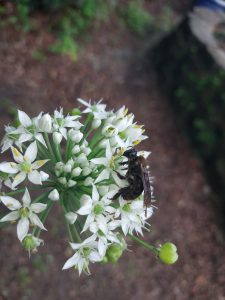Pesticides are an important part of any farmer’s Integrated Pest Management (IPM) to maintain low pests population and avoid economical losses. It is important that all pesticide applications are executed following label instructions to minimize pollution and unnecessary harm to living organisms. Among these living organisms are bees and other pollinators. Pollinators are organisms that help in the reproduction of plants transporting pollen from flower to flower. Some birds and mammals are considered pollinators, but arthropods, especially insects, are credited the most for pollination.
Strategies to Protect Bees and Other Pollinators From Pesticides
Pesticides when used according to label instructions should represent a low risk to the environment and living organisms. Regardless, it is a good practice to take extra precautions to protect bees and other pollinators when using these chemicals. Some of these precautions are as follows:
- Identify beekeepers with hives near the areas of the pesticide application – Before any pesticide application, make sure to notify beekeepers within your area in case they need to move their hive to avoid pesticide spray. Local government should be able to help you localize registered beekeepers. Contact Florida Department of Agriculture and Consumer Services (FDCAS) Beekeeper Registration page for more information.
- Use pesticides only when needed and where needed – Pesticides should only be applied if needed. For example, do a pesticide application only when plants are infested with pests, to avoid unnecessary risk to bees and other pollinators.

White, yellow and purple-blue flowers attract bees and other pollinators. Photo Credit: Luis Rodríguez UF/IFAS Extension. - Know pollinator behavior – Most bees and other pollinators forage during the day (8:00 am – 5:00 pm). It is better to spray during the night or early morning if possible.
- Do not contaminate water sources – Bees require water to cool their hives and feed their brood. Pesticide-contaminated water will create unnecessary risks to the bees.
- Do not spray attractive plants with insecticide before or during flowering – Avoid spraying flower plants that attract bees and other pollinators to avoid harming bees and other pollinators, specifically when using neonics pesticides.
- Understand systemic insecticide activity – Some systemic insecticides like, most neonics pesticides, can be partially absorbed by sprayed leaves and may cause sublethal effects to bees and other pollinators if it is moved into pollen or nectar. (Read the pesticide label for pollinators warnings).

- If you can, avoid spraying flowers with fungicides – Contaminated pollen with fungicides brought back to the hive can interfere with the function of beneficial fungi inside the bee colony.
- Beware of pesticide interactions – Some pesticides can be more toxic to bees and other pollinators when mixed rather than using them individually. For example, when propiconazole is mixed with pyrethroid insecticides, it may increase the toxicity to bees.
Conclusion
Bees and pollinators are very important for the pollination process. Without these organisms, it will be very difficult to produce crops the way we do today. We should always keep in mind bees and other pollinators when applying chemicals to crops to avoid unnecessary pesticide exposure among them.
For more information about pollinators and bees please access these “Ask IFAS” publications:
MINIMIZING HONEY BEE EXPOSURE TO PESTICIDES
EUROPEAN HONEY BEE APIS MELLIFERA LINNAEUS AND SUBSPECIES (INSECTA: HYMENOPTERA: APIDAE)
University of Florida is an Equal Opportunity Institution
 0
0

